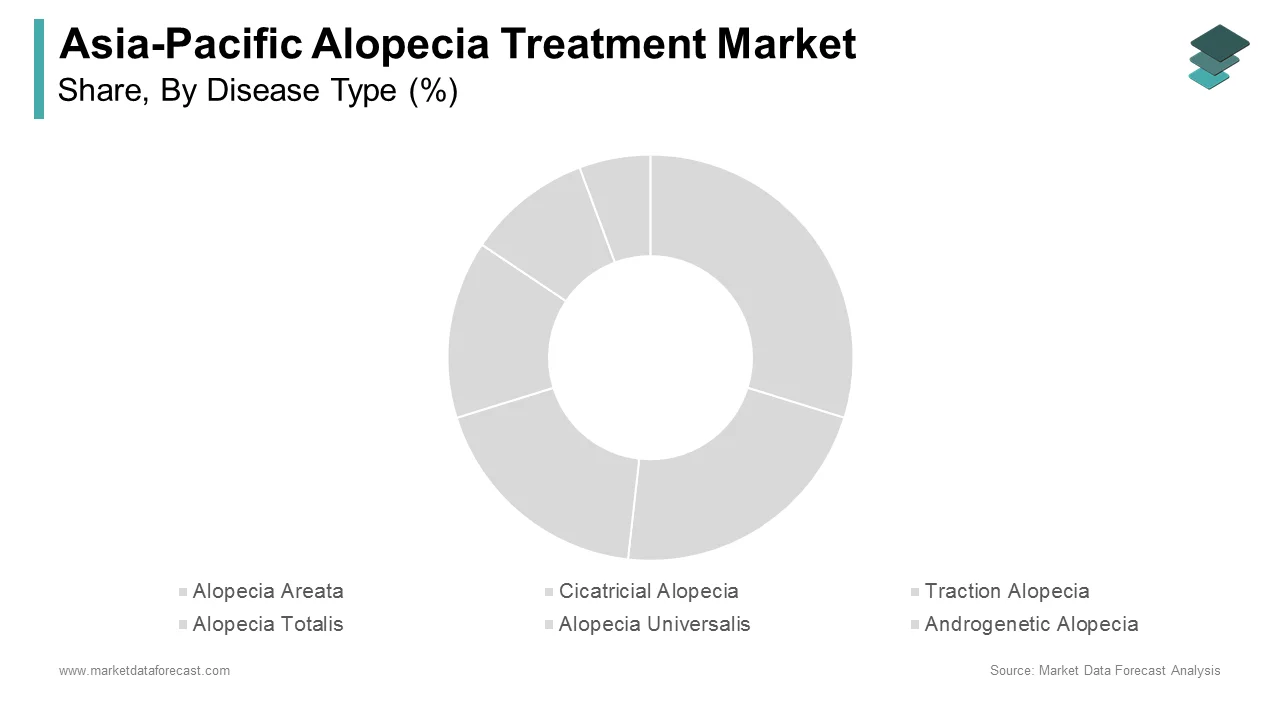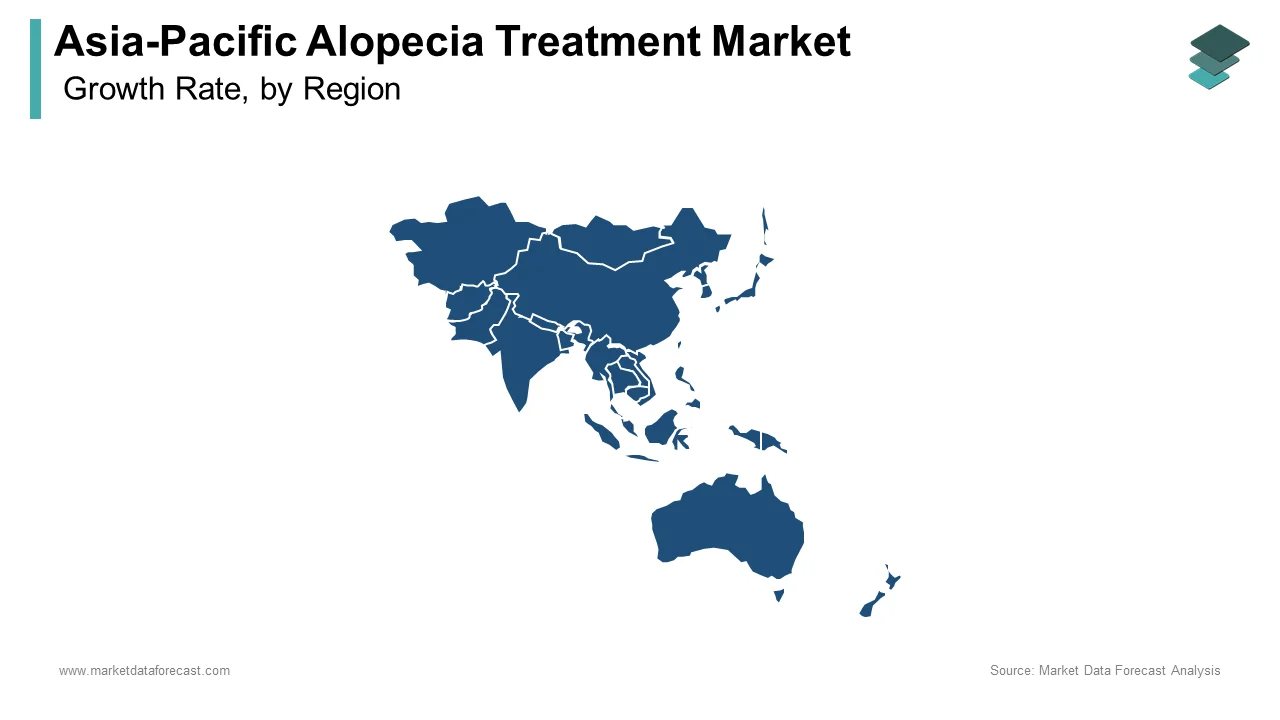Asia-Pacific Alopecia Treatment Market Size, Share, Trends & Growth Forecast Report By Disease, Treatment, Gender, Sales channel, End Use & Country (India, China, Japan, South Korea, Australia, New Zealand, Thailand, Malaysia, Vietnam, Philippines, Indonesia, Singapore and Rest of Asia-Pacific), Industry Analysis From 2025 to 2033.
Asia-Pacific Alopecia Treatment Market Size
The alopecia treatment market size in Asia-Pacific was worth USD 2.45 billion in 2024. The market size in Asia-Pacific is estimated to grow at a CAGR of 10.77% from 2025 to 2033 and be worth USD 6.14 billion by 2033 from USD 2.71 billion in 2025.

Alopecia is a medical condition that refers to sudden, excessive hair loss on the head area, mostly in circular patches. One such type of alopecia - Alopecia areata is a common autoimmune disease that causes baldness that results in partial or complete hair loss.
MARKET DRIVERS
The primary driver of the Asia-Pacific alopecia treatment market is the rising demand for effective hair loss treatment pharmaceuticals, particularly oral treatments. Oral hair loss treatment medicines are becoming more popular since they help to ensure patient safety by reducing the number of prescription dosages while increasing therapeutic efficacy. Other factors expected to fuel the market growth for alopecia treatment over the forecast period include increased stress levels among working-class populations, cosmeceutical drug manufacturers focusing on expanding their hair treatment and scalp treatment product lines, and cytokine therapy gaining traction for alopecia treatment. Either public or private payers do not reimburse most laser treatment services. Such services have a wide range of prices, and there is no way to standardize them.
Due to the increased penetration of alopecia products, rising disposable income, and expanding consumer spending, the market in the Asia Pacific is expected to grow at the fastest rate throughout the forecast period. Furthermore, as the regulatory environment in emerging nations improves, multinational businesses are expected to invest and take advantage of the available market prospects.
MARKET RESTRAINTS
On the other hand, the growth of the Asia-Pacific alopecia treatment market is projected to be hampered by the patent expiration of major pharmaceuticals, resulting in market exclusivity for particular brands and significant adverse effects connected with hair loss treatments. Allergies, melancholy, and the possibility of chronic sexual dysfunction are some of the adverse effects. The limited efficacy of hair loss treatment pharmaceuticals and a lack of reimbursement facilities for hair loss treatment services, such as laser treatments, are further market deterrents. The market's expansion is also being hampered by limited efficacy and a lack of evidence demonstrating the therapeutic usefulness of present hair loss medicines.
SEGMENT ANALYSIS
By Disease Type

REGIONAL ANALYSIS

Asia-Pacific is expected to develop at the quickest CAGR because alopecia treatment (hair loss) is rapidly expanding in Asia-Pacific countries due to the rapidly increasing male population and increasing awareness about hair loss treatment. The Asia-Pacific market is projected to be dominated by Japan. However, China is one of the world's leading countries, with fast-changing lifestyles, increased medical device manufacture, and increased use of herbal supplements. Hair loss treatment in Asia-Pacific is expected to surpass current volume consumption, primarily driven by an aging population, rising stress among the young, and pollution concerns, which are some of the key factors driving the Asia-Pacific alopecia treatment market. In addition, growing pollution and dietary changes are causing more significant hair loss issues in developing countries such as China and India, which is predicted to affect hair loss treatment product sales in these countries. The iGrow laser system by Apira Science was approved by the China Food and Drug Administration, making it the first laser-based hair growth technology to be certified in China.
KEY MARKET PLAYERS
Invacare Corporation, Carex Health Brands, Ottobock, Sunrise Medical Limited, Drive Medical Design & Manufacturing, Pride Mobility Products Corp., and GF Health Products, Inc. are a few prominent companies operating in the Asia-Pacific alopecia treatment market.
MARKET SEGMENTATION
This research report on the Asia-Pacific alopecia treatment market is segmented and sub-segmented into the following categories.
By Disease Type
- Alopecia Areata
- Male
- Female
- Cicatricial Alopecia
- Male
- Female
- Traction Alopecia
- Male
- Female
- Alopecia Totalis
- Male
- Female
- Alopecia Universalis
- Male
- Female
- Androgenetic Alopecia
- Male
- Female
- Others
- Male
- Female
By Treatment
- Pharmaceuticals
- Devices
By Gender
- Male
- Female
By Sales Channel
- Prescriptions
- OTC
By End Use
- Homecare Settings
- Dermatology Clinics
By Country
- India
- China
- Japan
- South Korea
- Australia
- New Zealand
- Thailand, Malaysia
- Vietnam
- Philippines
- Indonesia
- Singapore
- Rest of APAC
Related Reports
Access the study in MULTIPLE FORMATS
Purchase options starting from
$ 2000
Didn’t find what you’re looking for?
TALK TO OUR ANALYST TEAM
Need something within your budget?
NO WORRIES! WE GOT YOU COVERED!
Call us on: +1 888 702 9696 (U.S Toll Free)
Write to us: sales@marketdataforecast.com
